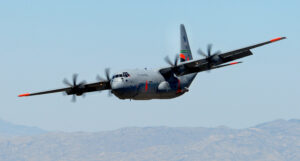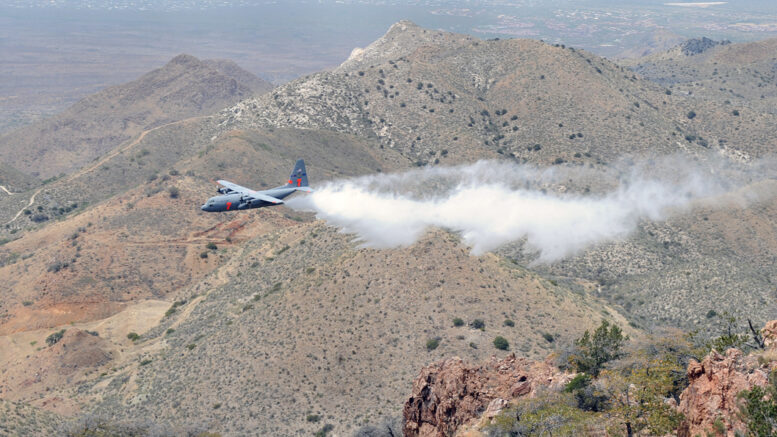Colorado chambers of commerce are asking Congress to spend roughly $1 billion to replace aging aircraft at Peterson Space Force Base in Colorado Springs — a move that would bolster firefighting capabilities and increase the base’s relevancy at a time of federal budget cuts.
The federal lobbying, which is being done in conjunction with a bipartisan group of state senators, is unusual for the 48 business organizations that signed onto the letter Tuesday to all 10 members of the state’s congressional delegation. But so are the stakes, as not only are national-defense and public-safety concerns on the line but hundreds of jobs and the long-term positioning of a military installation that, in combination with Schriever Space Force Base, has a $4.4 billion economic impact on the state.
The ask of the delegation — particularly of Democratic Rep. Jason Crow and Republican Rep. Jeff Crank, who sit on the House Armed Services Committee — is to fund replacement of eight C-130H planes built in 1994 with eight new-generation C-130Js. While the House won’t vote on the budget until August or September, committee members will mark up the National Defense Authorization Act in mid-summer, so a request for eight planes costing $80 million to $140 million each is a timely necessity.
And the Colorado impact would not be limited to the recipient Air Force base. Littleton-based Lockheed Martin has built the C-130 line of planes over their 71-year existence.
Impacts go well beyond firefighting capabilities
But the base is competing with other installations that also are looking to upgrade their line of C-130Hs, and the fear is that bases that can’t do so could be candidates for future downsizing or elimination of those units and the jobs they provide. The longer that certain bases have aircraft that are not interoperable with some new technology and that require specialized training for a limited lifespan, the more questions will arise on whether those aircraft units should remain in action at all, observers warn.
“If you have an aircraft that is more expensive to train aircraft crew for and maintain … then I think you end up being in a more critical struggle for their survival,” said Kenneth Moss, a senior representative for Lockheed’s C-130 business-development unit. “You have a crew force that not only is more expensive but limited on what they can do.”

A Lockheed Martin C-130J in flight
The eight C-130Hs at Peterson are part of the Air Force Reserve Command’s 302nd Airlift Wing, which employs about 1,300 assigned, mission-ready reserve airmen. In addition to offering support for Air Force global operations, the 302nd AW has, since 1993, been just one of four wings — the other three being Air National Guard wings — supporting the U.S. Department of Defense’s C-130 special mission of aerial firefighting.
To be sure, the C-130Hs at Peterson are not obsolete, but they have disadvantages when compared to the C-130Js.
Bigger, faster, further
The newer planes carry 33% more cargo while using less fuel, and they have a much easier digital interface with evolving computer programs that monitor aircraft operations and maintain safety. They are bigger planes that can carry more things faster and further, and they increase firefighting and operational capability, said Moss, a C-130 pilot who oversaw transition from the H line to the J line last decade at Yakima Training Center in Washington.
Only six Air National Guard units still fly the C-130Hs, though two of those are in the process of converting to C-130Js, and just three Air Force Reserve units, including the Peterson wing, still operate the older planes. Training on the older planes doesn’t translate to the newer ones, creating less of a return on investment for the military, and it is hard to mix the older and newer units on missions, Moss noted.
There aren’t members of Congress who oppose upgrading the old planes, per se, but there is a question of budget priorities, especially with President Donald Trump seeking cuts. While Colorado has suffered a spate of blazes that may seem to make keeping a firefighting unit here a no-brainer, those units operate also out of bases in Wyoming and Nevada, allowing for an argument that consolidation there won’t hinder public safety much.
Construction of the new planes will take between 36 and 42 months. So, while a delay in getting federal money for the conversion may not be fatal if the funding doesn’t come through this year, the clock very much is ticking.
Firefighting concerns spur statewide response
The push for the upgrades is heavy from the Colorado Springs region. The general chamber, women’s chamber and Philippine-American chambers from the area signed the business groups’ letter, and El Paso County’s two Democratic senators joined all 12 statewide GOP senators and Democratic Senate President James Coleman on a second letter.
But the list of signees to the letter spearheaded by the Colorado Chamber of Commerce included the main business organizations in areas ranging from Durango to Wellington and from Pueblo to Craig, reflecting the importance of the aircraft unit to the state. Signees emphasized the threat that wildfires, which are increasing in size and frequency and burned an average 7.5 million state acres annually for the past decade, pose to Colorado’s lives, communities, infrastructure, property, environment and overall domestic security.
“As the wildland wildfire risk increases, we are urging Congress support efforts to designate the 302nd AW in Colorado Springs to receive the next tranche of upgraded C-130Js,” both letters read. “This will ensure the Colorado-based unit maintains its mission relevance, with the most advanced airframe to support not only its aerial firefighting mission but also interoperability in supporting global combat support missions.”
